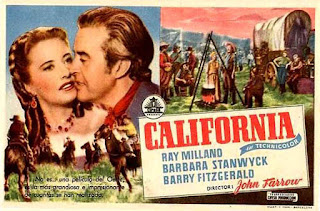Barbara Stanwyck in a Western - seems like it should be a perfect combination. Unfortunately, with California, other factors get in the way of making this a worthy venue for Ms. Stanwyck. First and foremost is the script - it's a hodge-podge of themes that don't ever come together effectively. First we have a gambling lady escaping to a new land, with a group of pilgrims seeking a new home. Next, it's an hysterical mob careening to the gold rush territory. Tnen, it's our gambling lady trying to run a saloon, and finally, it's a battle for statehood. Huh? All these points come across as separate story lines; there's no cohesion among them, which makes the story disjointed and unappealing. Even the fight scenes seem awkward.
Ms. Stanwyck is also working with an unfinished role: the character of Lily is not really fleshed out. We get a modicum of backstory (her father was a gambler), but then out of nowhere, Lily really wants to get married, and she's seemingly willing to take the first man who proposes, whether worthy of her or not. Add in the fact that there is no chemistry at all between Ms. Stanwyck and either Mr. Milland or Mr. Coulouris. Quite frankly, we thought Lily would have been better off with Barry Fitzgerald. Lily was originally earmarked for Betty Hutton (AFI catalog) but she declined to go on a honeymoon with her first husband. The remnants of Ms. Hutton probably remain the in singing numbers Ms. Stanwyck performs (with vocals by Kay St.Germaine).
Ray Milland was also the second choice; Alan Ladd had been assigned by Paramount, but he was in a salary dispute, so Mr. Milland was give the part. It's a thankless character - a trail boss, who (it turns out) is an army deserter. He's not very appealing, he's downright nasty to Lily. It defies even the idea of "meet cute" that he would be her love interest. Mr. Milland is a good actor, but he needs a character to work with, and he doesn't have one in this picture.
Anthony Quinn (Don Luis Rivera y Hernandez) has about two scenes. It was a role that deserved more development; because of the lack of distinction, when he's gone, you forget about him (which is not the point).
The only actor who manages to give his part distinction is Barry Fitzgerald. Michael Fabian is a good man: you like him and Mr. Fitzgerald's portrayal of him from the beginning. Though he unavoidably gets caught up in the script confusion, generally speaking, Michael's actions make the most sense of anyone in the story.
What the film does have is beauty - this is a lush technicolor film. Director John Farrow and director of photography Ray Rennahan use the background to good effect, presenting exquisite vistas of the California country-side (an early montage is an especially lovely piece of work). Edith Head's magnificent costumes for Ms. Stanwyck are breathtaking. And the necklace that Ms. Stanwyck wears in the picture below was a family heirloom that Mr. Farrow provided for use in the picture. It's amethyst, and has a matching tiara that Ms. Stanwyck also wears in the film.
The Lux Radio Theatre did a version of the film in January of 1950 with Ray Milland, Lizbeth Scott. and Raymond Burr. We were rather intrigued with the idea of Mr. Burr as Coffin - it seemed he might have brought a bit more sinister appeal to the part.
We were stunned to read a positive review of the film from Bosley Crowther of the New York Times, who said that California "glitters with a quite beguiling gleam" Unfortunately, we can't agree. If you are looking for a Barbara Stanwyck western, try Trooper Hook instead. In the meantime, here's a trailer from California:



























